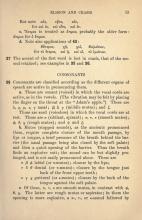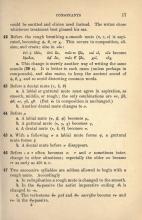38. Consonants are classified according to which organs of speech are active in pronouncing them.
a. Those are sonant (voiced) in which the vocal cords are active, as in the vowels. (The vibration may be felt by placing the finger on the throat at the "Adamʼs apple.")
λ, ρ, μ, ν, γ (nasal)
β, δ, γ (middle mutes)
ζ
Those are surd (voiceless) in which the vocal cords are at rest.
σ (sibilant, spirant)
π, τ, κ (smooth mutes)
φ, θ, χ (rough mutes)
ψ and ξ
b. Mutes (stopped sounds), as the ancients pronounced them, require complete closure of the mouth passage, by lips or tongue, a brief pressure of the breath behind the barrier (the nasal passage being also closed by the soft palate) and then a quick opening of the barrier. Thus the breath finds an explosive exit; the sound can be but slightly prolonged, and is not easily pronounced alone.
π, β, φ (labial or π-mutes; closure by the lips)
τ, δ, θ (dental or τ-mutes; closure by the tongue just back of the front upper teeth)
κ, γ, χ (guttural or κ-mutes; closure by the back of the tongue against the soft palate)
c. Οf these, π, τ, κ are smooth mutes, in contrast with φ, θ, χ. The latter are rough mutes or aspirates; in them the οpening is more explosive, a π-, τ-, or κ- sound followed by a distinct h-sound, as in top-heavy, hot-head, pack-horse. In the sonants β, δ, γ the breath is checked by the vibrating vοcal cords, so that less breath gathers for explosive exit than in the aspirates. The Greeks called these middle mutes, midway between the smooth mutes and the aspirates in the force οf the final element.
d. In the nasals, μ, ν, γ nasal, the nasal passage is open, the soft palate being lowered; thus the breath, after passing between the vibrating vocal cords, finds exit through the nose; the oral passage is closed, in μ by the lips, in ν by the flattened tongue against the front teeth (the lips being open), in γ nasal by the back of the tongue against the soft palate (the lips being open).
e. ψ for πσ, ζ for δσ (σ being probably made sonant), and ξ for κσ are called double consonants.
39. These relations are shown in the following table.
40. At the end of a word no consonant could stand but -ν, -ρ, or -ς, and no consonantal group but -ψ, -ξ, or -γξ. Any other single consonant at the end was dropped; any other group at the end caused some change.
a. Final -λς occurs in ἅλς (salt, sea); final -νς in Tῖρυνς (Tiryns). The proclitics ἐκ (οut of) and οὐκ, oὐχ (not) are almost a part of the following word, and so are hardly exceptions.
41. A final -ν (-ν movable) was added at will to some words.
Words in -σι (-ψι, -ξι)
Verbs in -ε in the third singular
ἐστι is
Sometimes the irregular ᾔει (went) and ᾔδει (knew).
a. Poetry and inscriptions alike show that -ν movable was freely added before vowels and consonants; before vowels it could be omitted and elision used instead. The writer chose whichever treatment best pleased his ear.




